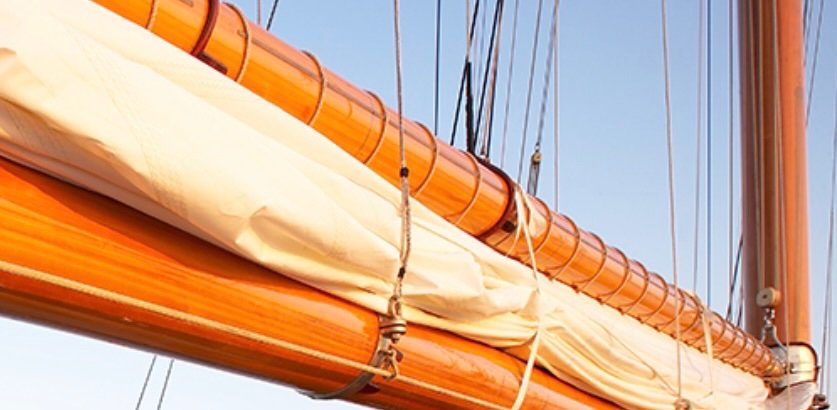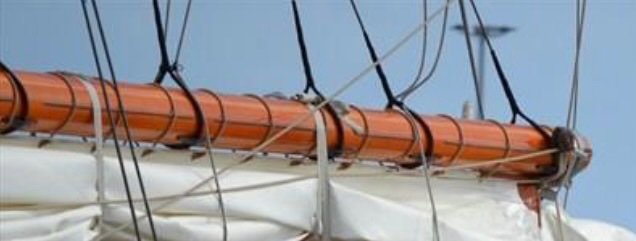-
Posts
3,944 -
Joined
-
Last visited
Content Type
Profiles
Forums
Gallery
Events
Everything posted by KeithAug
-
I finished off the other ends of the gaffs before moving on to the saddles. I started the saddle with a strip of 1/2" wide x .040" thick brass. This was milled along its length to a depth of .020" I marked out the ovals for the saddle on a piece of card and then attached it to the brass strip with double sided tape. I then cut out the ovals with a jewellers saw before finishing with a file. I then annealed the brass and bent the ovals around scrap lengths of steel bar of the same diameter as the masts. I then made the attachment brackets for the gaff out of strips of .020" brass. These were bent to the correct radius with the ends turned out to form the hinge brackets. The piece of aluminium is a spacer to get the brackets correctly positioned. The brackets were then soft soldered to the saddle. The stirrup for the gaff lift was then made. A piece of 3/32" tube was part turned to mark the cutting locations. Holes were then drilled and a piece of shaped .040" wire was bent, inserted and soldered. Finally the small bridging piece was soldered to form the eye. The tube was then cut away. The saddles were then mounted on the gaffs.
-
Druxey, Gary, Bill and Jon, Thank you all for your kind comments. It seems amazing that I started this build 3 years ago - how time flies. My hope is that some time this year I will get started on another build. As I get older I find myself rejecting long duration projects!
-
Great project. I must have seen her while visiting the museum, but don’t recollect. I look forward to seeing her develop.
- 30 replies
-
- small
- clinker built
-
(and 2 more)
Tagged with:
-
So now we know, it was you who was responsible for initiating Chinese world manufacturing dominance.
-
Very nicely done Rob - I must remember that.
- 3,560 replies
-
- clipper
- hull model
-
(and 2 more)
Tagged with:
-
Jon - In Scotland the wind always dies about 5 miles before the anchorage which inevitably means that the hook only goes down as dusk descends. Just as the last rays of sunlight fade the wind starts blowing at about 25 knots directly into the mouth of anchorage. My sailing pal says it is due to diaurnal variation but I just think winds are perverse. Jon - That's not too bad. I find it much worse when i leave the model all ship shape and then turn up the next morning to discover all the failures.
-
Brett - alternatively look up Gerald A Wingrove - he has written an number of books and you can find some of his work on MSW. Sadly Gerald is no longer with us. RIP.
-
Brett - this would be a good start:- https://www.amazon.co.uk/Model-Building-Brass-Ken-Foran/dp/0764354949
-
Arrrrgh! You have all shattered my dreams. I thought Valeriy had discovered some way of only making the solder go where he wanted it to go. I am a broken man!
-
The crew are obviously a bit pedantic about sanitary cleanliness. Don't you think that a bit of realism in the pan might add to the overall effect?🙂 Perhaps the door should be slightly ajar, with a glimpse of the seated occupant smoking his corn cob pipe.😀 You can see that I am very taken with your Bogs. Your work is beautifully neat as always.
-
Jon - I always struggle with making the sails look full. In the end I convince myself that its the end of a perfect day, the wind has failed and the crew have decided to partake in a round of gin and tonics before taking the sales down. This makes the set of the sails perfect.
-
Valeriy - your soldering is always very neat. You must tell me how you keep it so clean.
-
I moved on to gaffs. They were again made from mahogany dowel turned to the correct maximum diameter (the taper being left for later). The gaffs have features which in the majority lie on 0, 120 and 240 degree radial orientations. To make rotational location easy I drilled 3 location holes on a extension to the finished boom and then used these holes for location. I needed to cut 2 x .040" wide slots along the lengths of the gaff ad i did this on the table saw using a simple jig. A square cut out was made in a piece of scrap wood equal to the diameter of the gaff. A hole was drilled for a locating dowel. The gaff was mounted and the slot was cut with the saw fence bearing on the jig. With the slots cut the ends were milled to take the gaff saddle brackets. The .040" slots are for the wear strips - made form .040" brass wire. The wear strips are not continuous so I inserted thin strips of mahogany (cut to the correct length) to segment the slots. With this done I then sanded the tapers on both ends of the gaffs (the slots were deep enough not to be removed by the tapering). The brass wire wear strips were glued in with CA. The second gaff was made in the same way. Straps for locating the gaff hoist lines are positioned at the 120 and 240 degree rotational positions. The straps were cut from brass sheet and when drilled were inserted on pins so that the end radii could be filed in one operation. The gaffs were drilled to take the pins for the straps and the straps were mounted. The straps for the saddle were cut and shaped to fit the previously machined slots. The hoop and the end boss was also turned and milled. The straps were blended to the shape of the boom using a file and then the hoops were fitted.
-
Whatever happened to those beautifully elegant cargo vessels, alas their modern replacements have all the elegance of a floating brick. At least modellers can record their passing.
-
Thank you Pat, Richard and MCB for your comments, and thanks to everyone for the likes. Pat - I think i have not been as good at polishing of late however my general process is machine finish, polish with 600 grit wet and dry, then polish with 1200 grit, then 2400 grit and then finish with Brasso liquid polish. I generally tend to accept that brass ages however if I really want to prevent this I use Renaissance, Micro-Crystalline Wax Polish. A bit expensive but excellent for maintaining the shine for years. Update:- From an earlier post, Eberhard thank you - modified radar. You may also recall that I doubted the strength of the shackle attachment to the turnbuckles. That is the lower end in the next photograph. I proved they were not strong enough when rigging the bowsprit - Pinnnng!! Although not as accurate I modified all of them as follows - old version top - new version bottom. The mod involved using a vey small split pin made from .020" x .040" section brass strip. They are now much stronger and when not subject to close inspection they look fine. The bowsprit was rigged with .024" Beadalon clear coated multi strand steel wire. I bought wire guards to simulate thimbles and keep things neat. The end of the wire was stripped, threaded through a 1mm ID by 1.2mm OD tube then through the wire guard and then back through the tube. The loop was secured with a drop of CA and then heat shrink tube was used to simulate the leather protective sleeve. The "large" file in the photo is a standard needle file. I rigged the port side bowsprit shroud very tight to correct a slight bow in the bowsprit. This worked very well. Until --------- after about an hour ----- pinnnng. The attachment to the hull was too weak and parted company. The small bracket had been soldered to a 1/16" spigot and then inserted to a hole in the hull. The solder failed. The bracket was attached to a 3/32" spigot and reinserted. Thus far this has held despite the tension in the cable. The starboard bowsprit shroud didn't quite need as much tensioning and in consequence the hull bracket held (thus far). The bobstay was rigged next, again with a fair degree of tension.
About us
Modelshipworld - Advancing Ship Modeling through Research
SSL Secured
Your security is important for us so this Website is SSL-Secured
NRG Mailing Address
Nautical Research Guild
237 South Lincoln Street
Westmont IL, 60559-1917
Model Ship World ® and the MSW logo are Registered Trademarks, and belong to the Nautical Research Guild (United States Patent and Trademark Office: No. 6,929,264 & No. 6,929,274, registered Dec. 20, 2022)
Helpful Links
About the NRG
If you enjoy building ship models that are historically accurate as well as beautiful, then The Nautical Research Guild (NRG) is just right for you.
The Guild is a non-profit educational organization whose mission is to “Advance Ship Modeling Through Research”. We provide support to our members in their efforts to raise the quality of their model ships.
The Nautical Research Guild has published our world-renowned quarterly magazine, The Nautical Research Journal, since 1955. The pages of the Journal are full of articles by accomplished ship modelers who show you how they create those exquisite details on their models, and by maritime historians who show you the correct details to build. The Journal is available in both print and digital editions. Go to the NRG web site (www.thenrg.org) to download a complimentary digital copy of the Journal. The NRG also publishes plan sets, books and compilations of back issues of the Journal and the former Ships in Scale and Model Ship Builder magazines.








